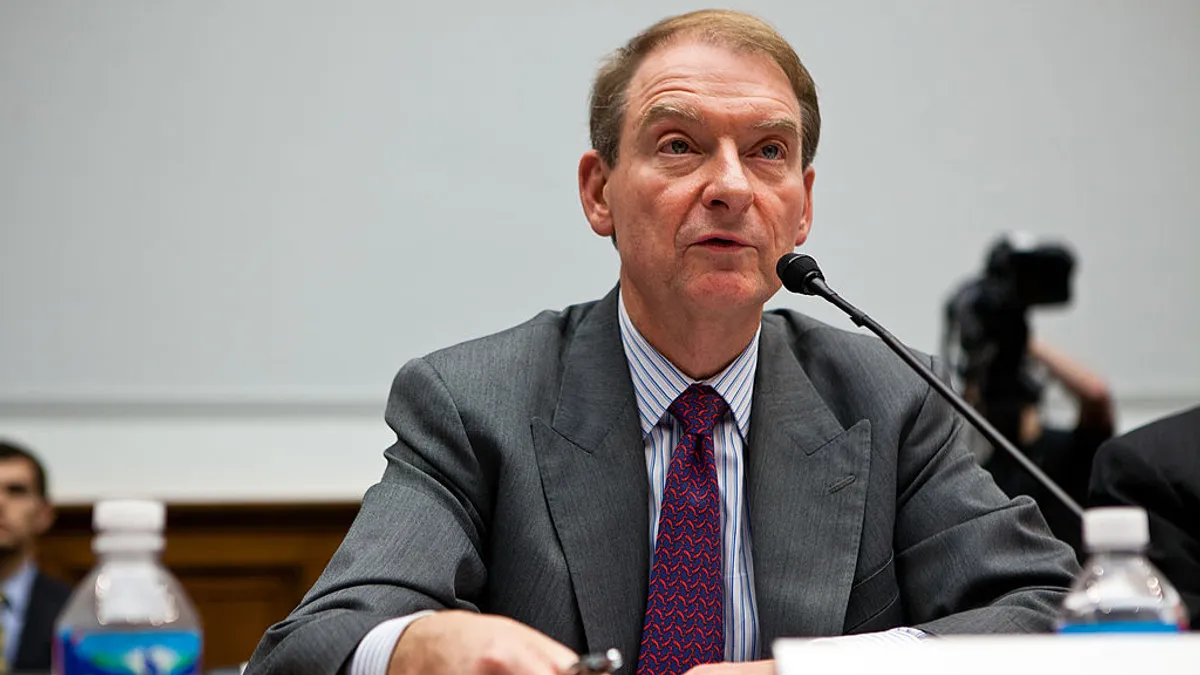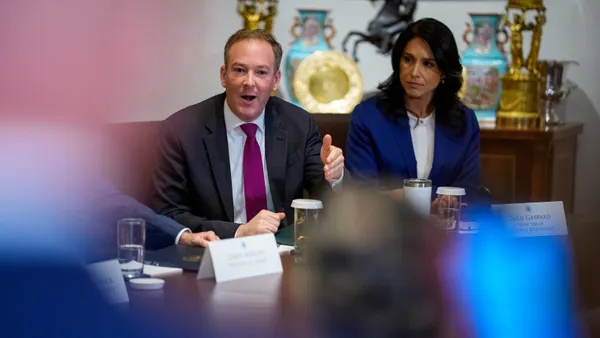The Science Based Targets initiative, an organization that validates that corporate sustainability goals align with leading climate science, released a draft revision of its Corporate Net-Zero Standard this spring that proposed substantial changes to the scope of the prior framework for setting climate targets.
The revisions would delineate company standards by size and location and separate scope 1 and scope 2 emissions, among other changes. SBTi said the standards largely looked to move corporate targets “from ambition to progress.” A recent study from Accenture found that only 16% of the world’s 2000 largest companies are on track to achieve net-zero emissions by 2050.
Sustainability Roundtable Inc. CEO James Boyle founded the strategic sustainability advisory firm in 2008, at the height of the financial crisis of the late aughts. Since then, the company has worked with over 100 Fortune 500 companies and created the Net-Zero Consortium for Buyers to aggregate procurement of utility-scale renewable energy.
Boyle told ESG Dive that his company’s clients “all take the Science Based Targets initiative seriously,” even if each does not fully participate, and “they've been very struck by the proposed revisions, which are substantial.”
“They were definitely concerned. It is a very high standard, which they don't resent. They like the fact it's a high integrity, challenging standard that most of them have been willing to invest in,” Boyle said in an interview. “However, they are concerned with the proposed revisions, and in particular, many are concerned with the lack of understanding about what specifically best accomplishes what the Science Based Targets initiative recommends.”
Editor’s note: This interview has been edited for length and clarity. This conversation took place prior to the SBTi consultation window closing.
ESG Dive: What are you hearing from your members and clients about the SBTi draft and what are they most encouraged or concerned by?
JAMES BOYLE: There are some recommendations, which all of our clients agree with wholeheartedly. Particularly, the recommendation that “companies should procure contractual instruments that result in additional renewable energy production, thereby directly contributing to grid decarbonization.” The problem is the proposed changes to the standard don't move that recommendation forward.
They move us farther away from that recommendation and the reason has a lot to do with scope 2 emissions — the emissions that accompany actions that the company doesn't itself do directly, but that a company causes to be emitted. Scope 2 emissions have been most impressively addressed by our clients by procuring renewable energy credits from projects they cause. The key notion is that they take the time and the effort to actually cause new renewable energy projects, and they use the [resulting] renewable energy certificates.
Large companies will always be managing non-financial items, like their human resources, their pollution and how they govern themselves internally, as a corporation. And that's E, S and G.

James Boyle
Sustainability Roundtable Inc. CEO
They cause these new renewable energy projects to happen by making a pre-financing commitment. Before the [project] is even financed, they commit to a minimum price, and it's a price that includes the bundled cost of both building the big new project and the commercial value of the environmental attributes certificates the project then produces. Our clients have, with our help, done the hard work of actually making these commitments, which is not an easy thing.
The project doesn't even exist yet, and they have to make a commitment that's long enough for the developer to go out and get [more] financing and say, “Don't worry about it, I have buyers, and they're on the hook. They actually signed a contract.” And banks will lend the developer the money, because they have buyers like our clients on the hook — in Europe, it's for a minimum of 10 years; in the United States, it's often a minimum of 15 years.
If you have high credit buyers on the hook for a minimum price for 15 years, and it's going to cover the full cost of the development of the project and the resulting environmental attribute certificate, it's not surprising that banks will provide that financing. It's not surprising the banks have provided that financing, and it's not surprising that therefore, more than 200 gigawatts of new renewable energy has been created this way, according to McKinsey.
In the United States in particular, this has been the main thing in terms of causing, [new] large-scale renewable energy. It's less popular and well known in Britain, where the Science Based Targets initiative is based, and so I think that's part of the reason they failed to understand how critical this approach is, which isn't reflected in the environmental attributes certificates themselves.
Editor’s note: The SBTi revisions recommend companies “procure contractual instruments conveying a zero-carbon electricity attribute that matches their operational electricity use both in time and geographic location.
Why do you believe the best approach is to focus on causing projects rather than location and time?
The environmental attributes certificates don't have, at least right now, a stamp on them that [explains] the project and the buyer cost. So there's a big debate that the Science Based Targets initiative is addressing between [whether] you try to buy environmental attributes certificates that are from the dirtiest grids first in order to help with carbon abatement or you buy environmental attribute certificates that are from the same location in the same time as your demand for electricity. Those are two different approaches, and unfortunately, there's a lack of clarity about what matters the most.
[In our opinion] what matters the most is actually not where the project is or what time the project is producing electricity, and the related environmental attribute certificates, it's whether or not you caused the product, because if you haven't caused the project,
It's an interesting thing that it's the same time and in the same location, and, on some level, that's probably better than if it wasn't in the same location, it wasn't at the same time. But before you even have that conversation, you could have a conversation about whether you're going to cause a project or whether you're just going to buy an inexpensive thing from a long existing project, which is much easier. The latter is much easier, it only takes minutes.
[So there’s] a difference between those two approaches, though they both end up with an environmental attribute certificate in your hands. But one represents what we call a purchaser-caused environmental attribute certificate, where you got that environmental attribute certificate because you actually caused the project. That's what we want the science based target initiative experts to understand.
Most environmental attribute certificates don't reflect somebody causing a new project. But just because that's true, that doesn't mean there isn't a right way to do this. People are doing it the right way, and that should be encouraged. [One of SBTi’s recommendations say] “you should procure contractual instruments, those are the environmental attributes certificates that result in additional renewable energy production,” we couldn't agree with that more. Now they just need their standard to be in accord with that which it currently is not.
What positive changes do you see in the draft?
There are a lot of changes in the draft that are constructive. SBTi has incorporated a lot of things that folks thought was a better approach, and they're making it part of the standard. There does have to be a recognition that this is hopefully going to inspire for-profit companies to do a lot of things. One sort of basic approach that isn't taken that seriously is, what is the nature of “feasible?”
[The draft uses] the word feasible several times, and we agree you should do what's feasible. But for a for-profit company, that almost means what is commercially feasible. There's what is technically feasible, and then there's what is commercially feasible.
Sure, it might be difficult to define these two things, but that doesn't mean these two things don't exist. They do exist, and they are different. And if you want to make the sort of change we need to make at the scale we need to make it, have companies doing what's commercially feasible first and, only then, doing something that's just a cost for them that's like philanthropy.
We're not going to philanthropy our way out of this problem. This has got to make for-profit companies money over time or it's not going to work. The good news is, it is [going to make companies money over time]. In the places where this can really work, like southern Illinois is coal country and moving from a coal factory to a solar factory in southern Illinois is a good commercial opportunity.
So, let's have companies do that first. And let's let companies do that first, because they can do that right now. [However,] they're not going to do that if the standard-setters don't recognize that's a better thing.
When people say they're anti-ESG, it sort of indicates they don't necessarily know what they're talking about. It's like being anti-RBI in baseball.

James Boyle
Sustainability Roundtable Inc. CEO
How is your membership responding to the climate risk disclosure landscape changes in the U.S. and European Union and the general direction ESG sentiment is taking?
Almost all of our clients are for-profit companies, and they really like predictability. So they haven't liked that things are so unpredictable.
Folks that aren't experienced with large companies, what they may not understand is that large companies will always be managing non-financial items, like their human resources, their pollution and how they govern themselves internally, as a corporation. And that's E, S and G, environmental, social and governance. I think if people step back from it, they'll all recognize that every company has E, S and G.
It isn't really an option, like it's just a reality. They have some pollution that they're worried about. They have human beings that they really value, and they need to recruit and retain. Then they have to have some governance system so they can run their company. So when people say they're anti-ESG, it sort of indicates they don't necessarily know what they're talking about. It's like being anti-RBI in baseball. It's an acronym [for runs batted in] that describes a hit that leads to a score. So you can’t say we can't have RBIs anymore in baseball, because how would you do that? How would you stop a fan from counting the runs batted in?
So, in the same way, how can you stop companies from trying to measure their relative excellence at controlling pollution, or their relative excellence at developing talent and human resources, or their relevant excellence about governing themselves. Certainly in America or anywhere in the world, a company has got to be free to score its relative excellence in these areas. How would you stop an investor from [judging whether a] company is particularly good at environmental matters, or it's particularly good at Human Resource matters, and it's got particularly good governance. So therefore, as an investor, I feel comfortable giving my money to that company, because I think they're probably not going to screw it up as much as a peer company that isn't on top of these things.
Now, the other company will have E, S and G, but they might not be managing it well. So as an investor, I've got to be free to say, “No, I prefer the company that is managing things well to the company that is not managing these things well.”
The whole idea of being anti-ESG, I think, just misunderstands that non-financial items are managed in companies. The only question is: are they smartly managed or not smartly managed?
Then you can have a good discussion about, “Okay, well, what is smartly managed?” That's a meaningful discussion because that is a tricky question, but there are answers.
What are your members’ concerns about the tariff situation with respect to their sustainability programs?
There's a lot of concern about tariffs. These are all global companies and tariffs, but I'll just speak for myself.
This is a tax on everything with all of our trading partners, and the impact is huge. The only thing worse than the near term impacts of incredible taxes on everything is the long term impact of incredible taxes on everything.
Our clients are overwhelmingly American companies, and they don't view this as good news. And one of the biggest reactions is everybody just pulls back from business and from making any investments because nobody knows what's going on.



















